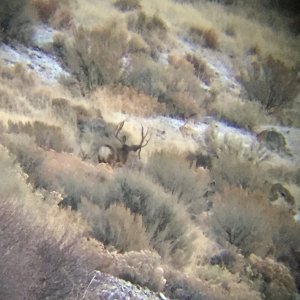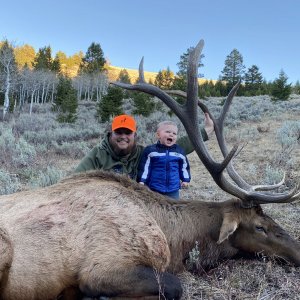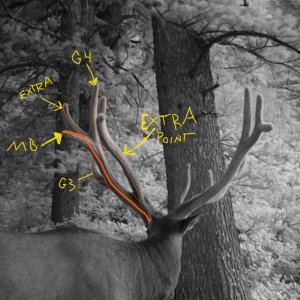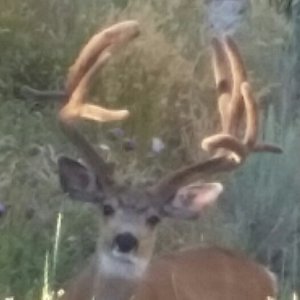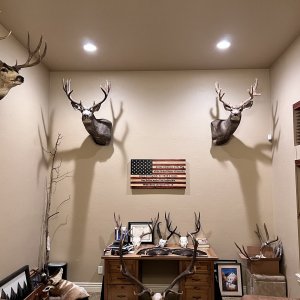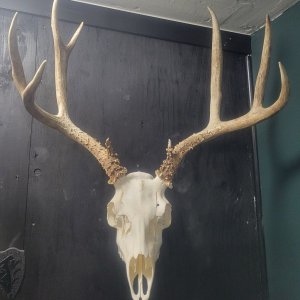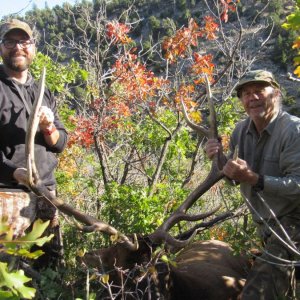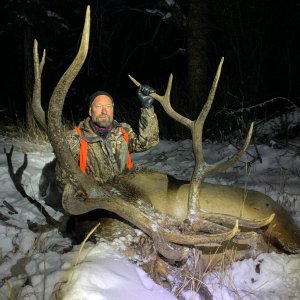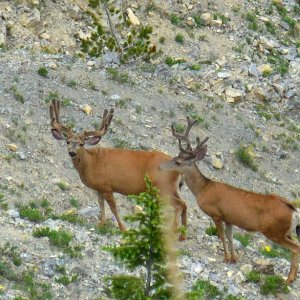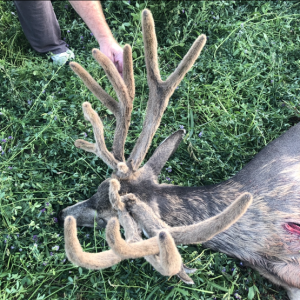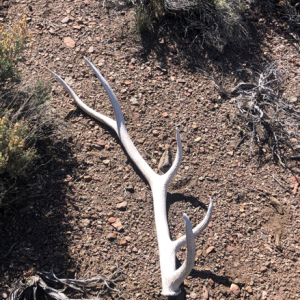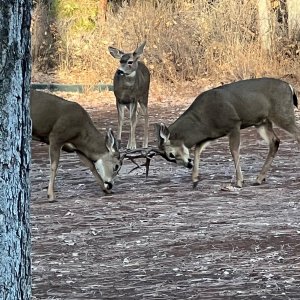You are using an out of date browser. It may not display this or other websites correctly.
You should upgrade or use an alternative browser.
You should upgrade or use an alternative browser.
Ted Riggs Tree in Kiabab
- Thread starter prohunter
- Start date
grizzlyplumber
Very Active Member
- Messages
- 1,182
dont know about him, whats his story?
D
Deadred7o7
Guest
Me still being a youngster at 28 who was/is Ted Riggs?
Kyle
"If it moves shot it again"
Kyle
"If it moves shot it again"
N
NMHUNTNUTT1
Guest
I know theres guy here who know more , but , Ted killed many , many a HUGE MULEY on AZ kAIBAB and Strip . He was a government trapper I believe , and was a driveing force to bring awareness about declining mule deer . He did things the old fashioned way , lots of hard work . He's the kind of guy you go to a camp fire and make sure there is alot of dry wood , sit back and listen to the stories. I can only imagine what it would be like to visit with him .Big muley bucks rested a little easier when he wasn't in the hills . Just a very respected man...
S
sureshot8
Guest
Left to right, Pat Bundy, Ted Riggs & Joe Walters

I'm guessing the picture was taken around 1970

I'm guessing the picture was taken around 1970
R
RLH
Guest
that's the only time i ever saw ted without a beard.
N
need2hunt
Guest
Trophy Hunter Magazine ran a story (or maybe a couple) about him a few years back. I believe he has killed more 30 inch plus mule deer bucks than anybody....I can't remember the exact numbers so I won't say but it's almost unbelievable!
S
SierraFool
Guest
That cant be 1970's I can tell by the dog, that model went out in the late 50's
shotgunjim
Active Member
- Messages
- 967
Ted Riggs would kick Kirt Darners a$$.
2
264Magnum
Guest
Convienient that out of the 3 issues of trophy hunter I've ever bought, one of them has the Ted Riggs tribute.






B
Bucher
Guest
Now that's what you call the perfect passing away story. Although Ted Riggs has left us, he has left behind some fabulous hunting stories for us to read and dream about. He is a true legend and I feel blessed that my grandfather and uncle has had the opportunity to meet and talk hunting with Ted and Pat Bundy. Although the deer heard isn't what it was three decades ago, you can't help but get excited when you hear of the success stories from Ted?s hunts.
Ted Riggs was Old School!
I stopped in Mesquite on my way to an archery deer hunt on the Kaibab in the early 90's. On a whim my hunting partner and I looked up Mr. Riggs' phone number and called him out of the blue and asked if we could stop in just to visit. We had seen the mounts at Ben Franklin's in St. George and heard plenty of stories. We were hosted by Mr. Riggs for the afternoon and stayed damned near all afternoon listening to stories about working and hunting on the strip.
There are a few others like Ted Riggs still around and if you know them you know what I'm talking about- appreciate them while you still can.
Slowbow
I stopped in Mesquite on my way to an archery deer hunt on the Kaibab in the early 90's. On a whim my hunting partner and I looked up Mr. Riggs' phone number and called him out of the blue and asked if we could stop in just to visit. We had seen the mounts at Ben Franklin's in St. George and heard plenty of stories. We were hosted by Mr. Riggs for the afternoon and stayed damned near all afternoon listening to stories about working and hunting on the strip.
There are a few others like Ted Riggs still around and if you know them you know what I'm talking about- appreciate them while you still can.
Slowbow
S
SamC
Guest
LAST EDITED ON Feb-28-06 AT 10:54PM (MST)[p]You are right about Ted being old school? I was very fortunate to have grown up his neighbor and was able to see some of the deer he brought in during his tenure as a guide and Govt. hunter on the Az strip.
But? even better I spent a week with him on the strip mapping his favorite ?honey holes? and recording his stories. He truly was a story teller and loved deer hunting. Few know that his all time favorite thing to do was shoot coyotes. He was an excellent shot, he also loved to trap. He hated Mt. Lions with a passion and was avid about getting them under control on his beloved strip country. This still hasn't happened.
Rusty did a great job of honoring him. Thanks Rusty!!
But? even better I spent a week with him on the strip mapping his favorite ?honey holes? and recording his stories. He truly was a story teller and loved deer hunting. Few know that his all time favorite thing to do was shoot coyotes. He was an excellent shot, he also loved to trap. He hated Mt. Lions with a passion and was avid about getting them under control on his beloved strip country. This still hasn't happened.
Rusty did a great job of honoring him. Thanks Rusty!!
S
SamC
Guest
LAST EDITED ON Mar-01-06 AT 00:03AM (MST)[p]Well? thanks huntjock, I mostly read and learn. But thanks for the invite and the kind words.
C
Chef
Guest
Nice tribute by TH mag.
It's nice to hear from people that met him, knew him, and just plain lived next door and hiked with him!
Awesome.
Chef
"I Love Animals...They're Delicious!"
It's nice to hear from people that met him, knew him, and just plain lived next door and hiked with him!
Awesome.
Chef
"I Love Animals...They're Delicious!"
N
NMHUNTNUTT1
Guest
Welcome Sam . My buddys dad Frank Winters knows you , he said you too are a great hunter . If I remember correctly , you killed a monster antelope in AZ a few years back , would love to see the pics of him . Heck , would love to just here some of your experiances at a camp fire . Any how , great to have a knowledgeable outdoorsman here at MM ....NMHUNTNUTT.... Frank used to live in Round Mtn NV , I believe they went back to Globe though
S
SamC
Guest
LAST EDITED ON Mar-02-06 AT 00:24AM (MST)[p]Thanks for the kindness NMHUNTNUTT1? I wish I was the one that got that goat, but it wasn?t me.
I have met a lot of folks through the years at shows and in the field. The name (Frank Winters) sounds familiar, but I can't say I can put a face to it.
I spend a lot of time out of doors in N. AZ and S. UT with a camera in hand, too much some say, and I also love to hunt.
Hope I run into you sometime, I would like very much to swap stories and talk the talk.
I have met a lot of folks through the years at shows and in the field. The name (Frank Winters) sounds familiar, but I can't say I can put a face to it.
I spend a lot of time out of doors in N. AZ and S. UT with a camera in hand, too much some say, and I also love to hunt.
Hope I run into you sometime, I would like very much to swap stories and talk the talk.
M
McKinney
Guest
This has been a great tread. Please keep the stories coming. Sam C and others....Please!!!!!!!!!!
McKinney aka Hiker
Proverbs 3:5-6
McKinney aka Hiker
Proverbs 3:5-6
AZBuckSnort
Very Active Member
- Messages
- 1,075
Besides taking wonderful mule deer photos & video, Sam's a heckuva cook with the dutch oven!
SamC, good to see that you do some reading and posting here. Glad you took some time out from your outdoor adventures to share a little bit. I have two of my favorit photos that you have taken, the 38-40" buck on the dirt pond bank and the nice drop horn buck that you turned the guy in after he poached the deer. Great bucks and I have them on my wall in my office and have looked at them for almost 10 years now. Great pics. Ted Riggs certainly knew the strip. Thanks for posting. As you can see, I mostly read and don't post much either.
S
SamC
Guest
Thanks LVTHNT, I'm still out there tryin to get a better photo. Hope I can afford to go digital soon. I appreciate that you enjoy some of my work, dang photo enhancement has really tipped the real photos over, and everyone wants the fakes these days. I must admit, they do look good? hope you have a good spring and summer and draw a good tag this fall.
B
bohuntn12
Guest
Samc Hey how are you, Just wanted to thank you I dont know if you remember me or not, We ran into one another a few years back bowhunting elk in s. Utah right after you killed a nice muley, you let me use your camp trailer and once again thanks, by the way I went home empty handed.
Thanks,
Paul
Thanks,
Paul
S
SamC
Guest
Hi Paul? yes, I remember well the Elk hunt, seems you passed on a couple of pretty good ones the afternoon we crossed trails, then they their disappearing act. I drew a tag last year in the same area and didn't get a bull either. Sure had fun though, used the same blinds we used but the area we hunted was void of elk???? Found them in the hay fields, I had a ball trying to get to the heard monsters but they just plain wouldn't do something stupid?
I called and huchie mama?ed them tons?
Hope all is well!
Sam
I proudly wear your decal on my outfit !!!!
I called and huchie mama?ed them tons?
Hope all is well!
Sam
I proudly wear your decal on my outfit !!!!
OutdoorWriter
Long Time Member
- Messages
- 8,340
LAST EDITED ON Mar-22-06 AT 04:01PM (MST)[p]Below is a snippet from an article I did about someone's big buck hunt on the Strip. This portion was a "color" aspect, as was a sidebar on the Bundy's. -TONY
***
The history of the Strip prior to the early 1900s is somewhat murky, however. We know the Mormons used timber from Mt. Trumbull to build a temple in St. George, Utah. We also know good populations of pronghorn antelope and desert bighorn sheep inhabited the Strip because local cattle baron Preston Nutter proposed that it be turned into a big-game refuge. Nothing ever came of it, though. And supposedly, Teddy Roosevelt brought a herd of gazelle from Africa and turned them loose somewhere on the Strip. Nobody knows what happened to them either.
Unlike the Kaibab, where the mule deer had been a mainstay back into the 19th century, the Strip herd has a much more recent history.
When the first settlers arrived and created Bundyville in the early 1900s, the area was nothing but dry sagebrush flats and pinyon-juniper forests, and about the only water available was on Mt. Trumbull. Some written accounts by those living on the Strip back then make it clear that seeing a deer was a rarity. For the most part, much of the land was marginal deer habitat anyway. The lack of water didn't help. As more ranchers began grazing their charges on the Strip, however, they built dozens of stock tanks to ensnare free-running water for the cattle and sheep.
In 1947, the U.S. Fish and Wildlife Service assigned Ted Riggs to the area as a predator control trapper. Using both traps and poison, Riggs made a serious dent in the coyote and lion populations.
Then the Bureau of Land Management (BLM), which controls the majority of land on the Strip, moved in during the early 1950s to improve the grazing habitat. With a heavy steel chain stretched between them, bulldozers ?chained? down entire stands of juniper and pinyon trees. They used this clearing technique on acres and acres of range.
New forage plants started growing almost immediately, and so did the deer herd.
Within a few years, the steady supply of water, increased browse and low predation helped the deer herd grow huge, even to the point where it threatened to overrun the available habitat. The Strip became a productive deer factory.
By the mid-1950s, hunters in Arizona learned about the excellent hunting and trophy-producing ability. Nearly anyone who wanted to venture into the remote area and endure hours of bumpy, dusty roads could tag a buck. If they had the patience and willpower to pass up the smaller ones, they had a very good chance at an outstanding trophy. Because the soil in the area mirrors the same mineral-rich type as that on the North Kaibab, antler growth was sometimes spectacular, with spreads often going well beyond 30 inches. Place names within the Strip such as Poverty Mountain, Mt. Dellenbaugh, Snap Point, Trumbull, Black Rock, Wolfhole and Seegmiller became well known for their big buck production.
At an old-line shack near Grassy Mountain, the graffiti-covered walls tell some of the story. In 1966, a local cowboy, Garn Esplin, scribbled, ?Saw 40-50 deer in the past two days.? Farther down the wall, in March 1963 ranch foreman Mel Wipple wrote, ?What's the matter with the deer hunters? There?s 10,000 deer here by the look of things.?
Even Riggs saw what was happening. In 1956, he rode his horse from the Wildcat Ranch to Snap Point. On the way, he counted deer; his one-day tally totaled 346 of them. More than half of them had antlers, and half of the bucks were four points or more.
Not surprisingly, three of the notable entries in the Arizona record book have Riggs listed as the hunter. His typical entry from 1968 scored 189. His two non-typicals scored 249 6/8 and 240 2/8. His last Strip deer, taken in 1988, was an 8x9 with double eyeguards.
Sadly, sometime in the late 1970s and early 1980s, the Strip no longer harbored a lot of deer. A lot of finger pointing occurred, but for the most part, the downward population trend happened because of several factors.
***
The history of the Strip prior to the early 1900s is somewhat murky, however. We know the Mormons used timber from Mt. Trumbull to build a temple in St. George, Utah. We also know good populations of pronghorn antelope and desert bighorn sheep inhabited the Strip because local cattle baron Preston Nutter proposed that it be turned into a big-game refuge. Nothing ever came of it, though. And supposedly, Teddy Roosevelt brought a herd of gazelle from Africa and turned them loose somewhere on the Strip. Nobody knows what happened to them either.
Unlike the Kaibab, where the mule deer had been a mainstay back into the 19th century, the Strip herd has a much more recent history.
When the first settlers arrived and created Bundyville in the early 1900s, the area was nothing but dry sagebrush flats and pinyon-juniper forests, and about the only water available was on Mt. Trumbull. Some written accounts by those living on the Strip back then make it clear that seeing a deer was a rarity. For the most part, much of the land was marginal deer habitat anyway. The lack of water didn't help. As more ranchers began grazing their charges on the Strip, however, they built dozens of stock tanks to ensnare free-running water for the cattle and sheep.
In 1947, the U.S. Fish and Wildlife Service assigned Ted Riggs to the area as a predator control trapper. Using both traps and poison, Riggs made a serious dent in the coyote and lion populations.
Then the Bureau of Land Management (BLM), which controls the majority of land on the Strip, moved in during the early 1950s to improve the grazing habitat. With a heavy steel chain stretched between them, bulldozers ?chained? down entire stands of juniper and pinyon trees. They used this clearing technique on acres and acres of range.
New forage plants started growing almost immediately, and so did the deer herd.
Within a few years, the steady supply of water, increased browse and low predation helped the deer herd grow huge, even to the point where it threatened to overrun the available habitat. The Strip became a productive deer factory.
By the mid-1950s, hunters in Arizona learned about the excellent hunting and trophy-producing ability. Nearly anyone who wanted to venture into the remote area and endure hours of bumpy, dusty roads could tag a buck. If they had the patience and willpower to pass up the smaller ones, they had a very good chance at an outstanding trophy. Because the soil in the area mirrors the same mineral-rich type as that on the North Kaibab, antler growth was sometimes spectacular, with spreads often going well beyond 30 inches. Place names within the Strip such as Poverty Mountain, Mt. Dellenbaugh, Snap Point, Trumbull, Black Rock, Wolfhole and Seegmiller became well known for their big buck production.
At an old-line shack near Grassy Mountain, the graffiti-covered walls tell some of the story. In 1966, a local cowboy, Garn Esplin, scribbled, ?Saw 40-50 deer in the past two days.? Farther down the wall, in March 1963 ranch foreman Mel Wipple wrote, ?What's the matter with the deer hunters? There?s 10,000 deer here by the look of things.?
Even Riggs saw what was happening. In 1956, he rode his horse from the Wildcat Ranch to Snap Point. On the way, he counted deer; his one-day tally totaled 346 of them. More than half of them had antlers, and half of the bucks were four points or more.
Not surprisingly, three of the notable entries in the Arizona record book have Riggs listed as the hunter. His typical entry from 1968 scored 189. His two non-typicals scored 249 6/8 and 240 2/8. His last Strip deer, taken in 1988, was an 8x9 with double eyeguards.
Sadly, sometime in the late 1970s and early 1980s, the Strip no longer harbored a lot of deer. A lot of finger pointing occurred, but for the most part, the downward population trend happened because of several factors.
N
NONE
Guest
Great site I finally found a place on the web for me. This is the kinda stuff I love . Amazing finding that tree with Teds sig. I love the Az strip country and southern Utah truly Gods country.
N
NONE
Guest
thanks Butthead
C
Chef
Guest
LOL
That's Beavis!
Welcome None.
Chef
"I Love Animals...They're Delicious!"
That's Beavis!
Welcome None.
Chef
"I Love Animals...They're Delicious!"
N
NONE
Guest
DOH!
T
triggerhappy
Guest
That has to be one of the best threads I've read anywhere.
Thanks to all who contributed!
Thanks to all who contributed!
T
theridge
Guest
Not to be a smart arse or trying to get a laugh out of anyone in particular.....but, while hunting in the Saddle Mtn Wilderness I ran into a tree that had the name Ted Bundy etched into it. It also had a date but I can't recall what year it was. I think Ted Bundy was a murderer and cannabal. Could be wrong about that and it's highly unlikely that it's the same Ted Bundy.
Roy
Moderator
- Messages
- 7,446
Ted Bundy was not a cannibal. He was however a serial killer and was executed for it. You should tell someone about that tree though - if you seriously did see it. He had a lot of victims that were never found - there is probably a body buried near by. If it was the same Ted Bundy. But enough about that good for nothing monster. Let's hear more stories about TED RIGGS - a true MONSTER MULEY hunter.
ROY
ROY
Roy & ridge,
You are getting the wrong Ted Bundy mixed up here. There was and still is a family of Bundy's that live in that part of AZ. In fact, there are a few Bundy's that are licensed Outfitters for the AZ strip area.
The Ted Bundy that you are refering to, probably never made it to AZ.
Brian
You are getting the wrong Ted Bundy mixed up here. There was and still is a family of Bundy's that live in that part of AZ. In fact, there are a few Bundy's that are licensed Outfitters for the AZ strip area.
The Ted Bundy that you are refering to, probably never made it to AZ.
Brian
Roy
Moderator
- Messages
- 7,446
Well he did make it to Washington, Utah, Colorado, and Florida, so Arizona isn't too unlikely, though there are a lot of different Bundy's out there. That's why I said - if it is the same one. He did carve his name on a quakie in Utah near one of his victim's burials and one other time in WA. He pretty much detailed where most of his victim's were buried before he got the juice too - I don't think AZ was in there. But it would be creepy none the less to see Ted Bundy carved on a tree.
I found a tree with the name Al Bundy carved on it. It even had a very crude picture of a shoe salesman relaxing on a couch after a hard day at work stuffing his hand down his pants.
Anyway - enough of that. MORE TED RIGGS STORIES! Please.
ROY
I found a tree with the name Al Bundy carved on it. It even had a very crude picture of a shoe salesman relaxing on a couch after a hard day at work stuffing his hand down his pants.
Anyway - enough of that. MORE TED RIGGS STORIES! Please.
ROY
C
CUTTHROAT
Guest
Or a teenager in 1975, trying to trick everybody. Those scars aren't 60 years old.
B
Boots
Guest
As noted there are several of his racks displayed at Hurst Sporting Goods / Ace hdwr in St. George. Its on the SG Blvd /Bluff and just a couple miles off I-15.
I am in awe everytime I visit.
I am in awe everytime I visit.
OutdoorWriter
Long Time Member
- Messages
- 8,340
LAST EDITED ON Apr-05-06 AT 07:49AM (MST)[p]Here's a sidebar to the article referenced above. It's probably a bit out of context because Clay Bundy is mentioned in the main article. He helped guide the hunter to his big buck. -TONY
***
The somewhat vague history of the Arizona Strip tells us the first white men to visit the area were Dominguez and Escalante when they traveled along the base of the Hurricane Cliffs on their return trip from central Utah in 1776. Nearly a century later, other Anglos attempted to take advantage of the area?s vast land resources, but conflicts with native tribes occurred as the newcomers quickly laid claim to the best water sources and vegetation. Disputes between settlers and the Navajo, Paiute and Ute tribes culminated in the Black Hawk Navajo Wars of 1866-1869. By 1870, Mormon paramilitary action had mostly quelled the native resistance, eventually leading to the "Treaty of Mount Trumbull" and the establishment of several Paiute reservations.
Although the settlers included a colorful array of ranchers, sheepmen, cowboys and outlaws, the majority of the newcomers were Mormons, dispatched by the Church of Latter Day Saints to lay claim to the choicest land and resources before non-Mormons settled them. A number of large ranches were established, as well as a sawmill and a large dairy, and the rights to limited water sources of the region were swiftly claimed, though often without "valid government title." Range wars -- often settled with guns -- were quite common in this lawless frontier, and cattle rustling was a crime with hanging as its punishment.
Immigration to the Strip was encouraged by two events in 1916: the Stock Raising Homestead Act and the opening of a half million acres of Utah?s Dixie National Forest to homestead entry. In addition, a climatic shift early in the 20th century brought increased rains and snows, which filled water holes and allowed the grasslands to grow lush.
About the time of the immigration surge to the Strip country, Abraham Bundy and his family had been living in the Mormon colony of Moroles, in the state of Sonora, Mexico. But Poncho Villa and the Mexican Revolution of 1912 forced them to seek out a gentler environment. So Abraham brought his wife, eldest son Roy and several daughters to Arizona in 1916, where they settled in an area near the Hurricane Cliffs, not too far from 8,000-ft. Mt. Trumbull. Bundyville, also known as Mt. Trumbull, became the Strip's largest community. Eventually, nearly 300 people lived in the town, which included a schoolhouse that was built in 1922. Roy Bundy just happens to be Clay Bundy?s grandfather, and Clay went to classes until the third grade in Bundyville?s tiny schoolhouse.
Today, little remains of Bundyville. The school had been abandoned in the early 1960s, then later restored. It recently burned, but it's demise as part of the Strip?s history won't last long. Clay Bundy is a contractor and has already made plans to restore it once again. He also still owns a cabin on a ranch near Bundyville. It sits on land that belonged to Roy Bundy until Clay?s father, Orvel, bought it.
***
The somewhat vague history of the Arizona Strip tells us the first white men to visit the area were Dominguez and Escalante when they traveled along the base of the Hurricane Cliffs on their return trip from central Utah in 1776. Nearly a century later, other Anglos attempted to take advantage of the area?s vast land resources, but conflicts with native tribes occurred as the newcomers quickly laid claim to the best water sources and vegetation. Disputes between settlers and the Navajo, Paiute and Ute tribes culminated in the Black Hawk Navajo Wars of 1866-1869. By 1870, Mormon paramilitary action had mostly quelled the native resistance, eventually leading to the "Treaty of Mount Trumbull" and the establishment of several Paiute reservations.
Although the settlers included a colorful array of ranchers, sheepmen, cowboys and outlaws, the majority of the newcomers were Mormons, dispatched by the Church of Latter Day Saints to lay claim to the choicest land and resources before non-Mormons settled them. A number of large ranches were established, as well as a sawmill and a large dairy, and the rights to limited water sources of the region were swiftly claimed, though often without "valid government title." Range wars -- often settled with guns -- were quite common in this lawless frontier, and cattle rustling was a crime with hanging as its punishment.
Immigration to the Strip was encouraged by two events in 1916: the Stock Raising Homestead Act and the opening of a half million acres of Utah?s Dixie National Forest to homestead entry. In addition, a climatic shift early in the 20th century brought increased rains and snows, which filled water holes and allowed the grasslands to grow lush.
About the time of the immigration surge to the Strip country, Abraham Bundy and his family had been living in the Mormon colony of Moroles, in the state of Sonora, Mexico. But Poncho Villa and the Mexican Revolution of 1912 forced them to seek out a gentler environment. So Abraham brought his wife, eldest son Roy and several daughters to Arizona in 1916, where they settled in an area near the Hurricane Cliffs, not too far from 8,000-ft. Mt. Trumbull. Bundyville, also known as Mt. Trumbull, became the Strip's largest community. Eventually, nearly 300 people lived in the town, which included a schoolhouse that was built in 1922. Roy Bundy just happens to be Clay Bundy?s grandfather, and Clay went to classes until the third grade in Bundyville?s tiny schoolhouse.
Today, little remains of Bundyville. The school had been abandoned in the early 1960s, then later restored. It recently burned, but it's demise as part of the Strip?s history won't last long. Clay Bundy is a contractor and has already made plans to restore it once again. He also still owns a cabin on a ranch near Bundyville. It sits on land that belonged to Roy Bundy until Clay?s father, Orvel, bought it.



